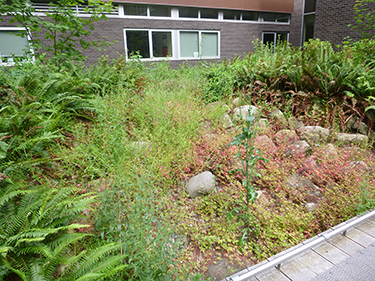|
Subscribe / Renew |
|
|
Contact Us |
|
| ► Subscribe to our Free Weekly Newsletter | |
| home | Welcome, sign in or click here to subscribe. | login |
Construction
| |
 |
August 30, 2018
How enviro consultants can lend your school project a helping hand
The Watershed Co.

Lund
|
Successful school design is a collaboration among the district, expert architects and engineers, and a passionate school community. However, there is another factor that is often overlooked: environmentally sensitive areas and the regulations that protect them.
Normally, environmental professionals, like wetland scientists and planners, account for these complicating “trouble spots” early in the process and their report gets referenced throughout the ensuing design.
Much like natural systems themselves, designs change. Walkways are moved, parking lots are expanded, site circulation can take new turns. In each case, environmental regulations can be a disruptor to the architectural and engineering design team’s plans and the project’s overall schedule.
By involving environmental professionals throughout the project, school districts and design teams can find new opportunities, instead of obstacles, to personalize the site to the school community.
Leaning in
Take Bellevue School District’s Cherry Crest Elementary, for example. An important part of the district’s project to increase capacity at the school was to rebuild it with a new classroom wing.
Unfortunately, the building’s new footprint put it over an existing stormwater outfall, classified by the city as a protected stream channel that supports local habitat functions. The project team planned to pipe and relocate the outfall to a new open channel closer to the forest surrounding the school, but to follow the city’s land use code protecting streams they also needed to mitigate for the loss of open stream channel.
There are commonly two options for accounting for this kind of environmental impact: recreate the stream channel elsewhere or enhance the remaining channel’s habitat value. Both solutions would need an environmental study.
Yet an in-person study of an area’s critical areas and habitat can also foster ideas. When my team and I walked through Cherry Crest Elementary campus’ southern end, we found a forest with abundant snags, downed logs and healthy wetland, as well as paths and sidewalks that connect the school to Cherry Crest Park and nearby Bridle Trails State Park.
Instead of simply recreating the entire length of lost channel, we suggested the team lean into the area’s strengths as an urban refuge for people and wildlife. Together, we were able to find a solution that maintained the local footpaths, planted native and drought-resistant trees and shrubs throughout the site’s developed sections, and enhanced the site’s habitat with native songbird nest boxes and large woody debris.
Conveniently, this approach blended well with the neighborhood’s expressed desire for more vegetative screening.
Building public support
From high-occupancy parking to athletic fields, most schools have a variety of land uses that may not fit seamlessly into established zoning rules.
To account for these differences, some schools districts need to work with their jurisdictions on permitting, sometimes called “conditional use,” to determine the exact need and the benefit it provides the community. At the end of the permit-review process, the jurisdiction holds public hearings, where school districts and the design team answer questions from the jurisdiction and public alike about how the project will affect the site.
Even though many of these improvements are born from community desires and concerns, these meetings can be stressful and ripe for misunderstanding. The school district and the design team need not only need to answer technical questions, but also respond to more abstract concerns from residents who may not have been part of the initial process and don’t have the background to understand why, for example, more plants and large woody debris can make up for a prominent tree being taken down.
An environmental professional can provide a useful dynamic to these meetings — be it as sympathetic and informed ear or a neutral third party that explains the science-based laws and the local regulations that must implement them. In each case, environmental professionals can help raise a discussion out of a perceived political or emotional context, providing an unbiased explanation for project decisions.
An outdoor classroom
Not all projects burden the environment. In the case of Bellevue School District’s demolition and expansion of Odle Middle School, the design team actually recreated 4,000 square feet of wetland buffer by relocating an athletic field elsewhere on the campus. Native vegetation was designed to take its place, creating an opportunity for the school’s science program to teach students about ecological diversity and habitat function.
For the design team, the question then became how to enhance the area’s potential as an outdoor classroom without introducing new problems or accidentally running afoul of buffer-related regulations. By working with environmental professionals throughout the process, the design team addressed regulations proactively in their plans and installed walking paths and seating that draw students close to natural processes without harming them.
The collaboration continued with the development of an interpretive sign program that illustrates the field’s environmental restoration and provides interesting facts for further class discussion.
Meeting needs
As our communities become more urbanized and schools are built and redeveloped to meet growing populations, school districts will need to find creative solutions to comply with environmental regulations.
Incorporating environmental professionals into the design process makes it easier for design teams to meet these requirements and opens up new possibilities to develop calm learning spaces, where students can learn firsthand about the great places where they live.
Nell Lund is a senior ecologist at The Watershed Co., a Kirkland-based environmental services and landscape architecture firm servicing school districts, municipalities, and commercial and residential clients throughout Washington.
Other Stories:
- It's much easier for schools to get to net zero
- UW Life Sciences Building: giant firs and bird songs offer a one-of-a-kind elevator ride
- 3 keys to building green schools: design, operations and renewables
- Bremerton alternative school breaks down walls to learning
- Studies suggest design really can affect how well students learn
- The view from inside a school: what really makes it safe
- Eastside Prep’s versatile arts hall made for concerts, plays and yoga
- After two decades, UW’s SLU campus nears completion
- How playgrounds make all children feel welcome
- See-through schools spark interest in learning
- Schools have more ways than ever to go green
- OSU football center opts for flexible lighting scheme
- Stretch your tight budget by getting creative
- Long-distance teams worked in concert to remake Wyoming school theater



